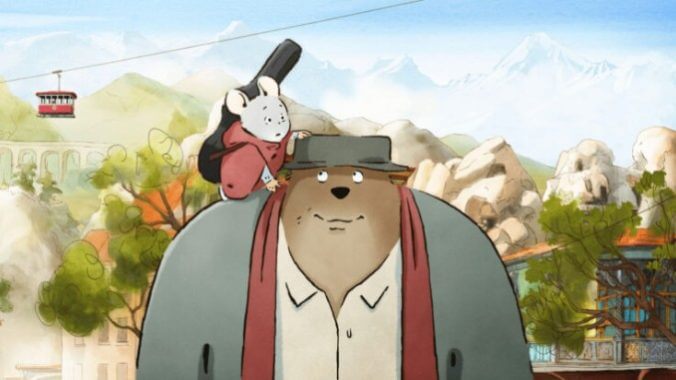Ernest and Celestine: A Trip to Gibberitia Fights the Power in Sweet Sequel

A crowd of bears gathers around a piano. A lone musician sits on its bench, earnestly cracking his fingers in preparation for what’s to come. The concert begins; it’s a lackluster musical performance executed on a single piano key. When the noise ceases, the onlookers erupt into applause.
In Ernest & Celestine: A Trip to Gibberitia, the curious scene described above (which, admittedly, sounds like the setup of a mind-numbing riddle) is actually a startling portrait of life under authoritarian rule. At the start of this sequel to Ernest & Celestine—the lauded 2012 animated feature by directors Benjamin Renner, Vincent Patar and Stéphane Aubier—Celestine (Pauline Brunner) has accidentally broken Ernest’s (Lambert Wilson) beloved “Stradibearius” violin. This mishap prompts the adorable mouse and bear duo to embark on an action-packed expedition to Ernest’s country of Gibbertia, which is home to the only luthier who can repair the instrument. The pair arrive at the mysterious territory searching for the craftsman, but are instead shocked to learn that all forms of music have been criminalized in Gibbertia. A land once recognized across the globe for its phenomenal musical talent has now become intolerant to even the sweet melodies of birds chirping in the morning light. Up against henchmen-like “music police,” familial dysfunction and a government which refuses to let go of its old ways, Ernest and Celestine must harness the powers of nonconformity and friendship to challenge the status quo.
Like all worthwhile children’s work, Ernest & Celestine: A Trip to Gibberitia is driven by something deeper than the need for superficial laughs or spectacles: The desire to inspire its young audience to pursue their passions and stand up against authorities that threaten their freedom of expression and individuality. Following in the spirit of films like Mon Oncle and Brazil, Gibberitia employs situational absurdity to emphasize the nonsensicality of rules taken to extremes. Gibberitia’s self-identified music police are, on occasion, seen hosing down song birds, harassing street musicians and scaling the sides of buildings to seize illegal paraphernalia (a dangerous accordion). Similarly, signs with crossed-out musical notes and mottos that read “That’s just how it is” underscore the dread found in authoritarian states and how illogical dictator’s bizarre rules can be. The country did, afterall, get its name from the word “gibberish.”
What’s especially refreshing about Ernest & Celestine: A Trip to Gibberitia’s moral arc is that its protagonists are not necessarily fighting against a singular villain, but rather deep-rooted, systemic issues that suppress the freedoms of all Gibbertians. The film highlights how a rule that requires children to follow the professions of their parents is closely connected to Gibberitia’s banning of all non-single-note-music, forwarding the idea that certain laws may not always be in humanity’s best interest and that one has the ability to bring tangible sociopolitical change for causes they care deeply about. Gibberitia drills in the notion that we shouldn’t take things at face value. “That’s just how it is” simply isn’t good enough when threats to our freedom/creativity exist.
The rebellious spirit of A Trip to Gibberitia is further communicated by non-narrative devices such as its colorful musical score. Composed and orchestrated by Vincent Courtois, Gibberitia’s non-diegetic sonic landscape is colored by rich influences of Balkan ska and Romanian marriage dances. The upbeat sound of the film’s many chase sequences create a joyful experience, in which rebellion—for a just cause—is not just something to be celebrated, but something that feels intrinsically human.
-

-

-

-

-

-

-

-

-

-

-

-

-

-

-

-

-

-

-

-

-

-

-

-

-

-

-

-

-

-

-

-

-

-

-

-

-

-

-

-








































